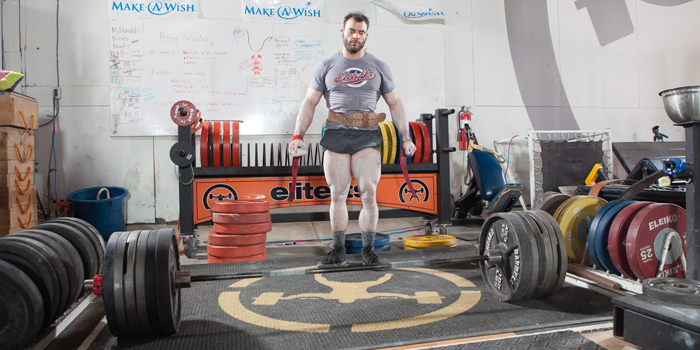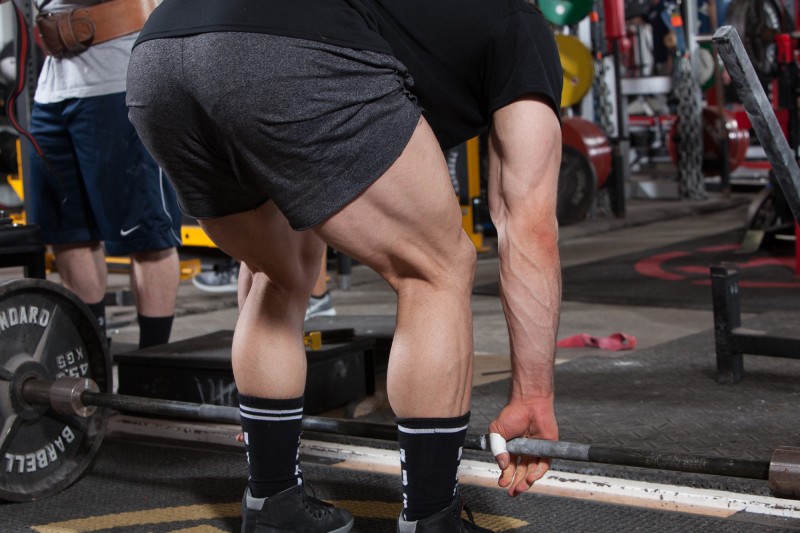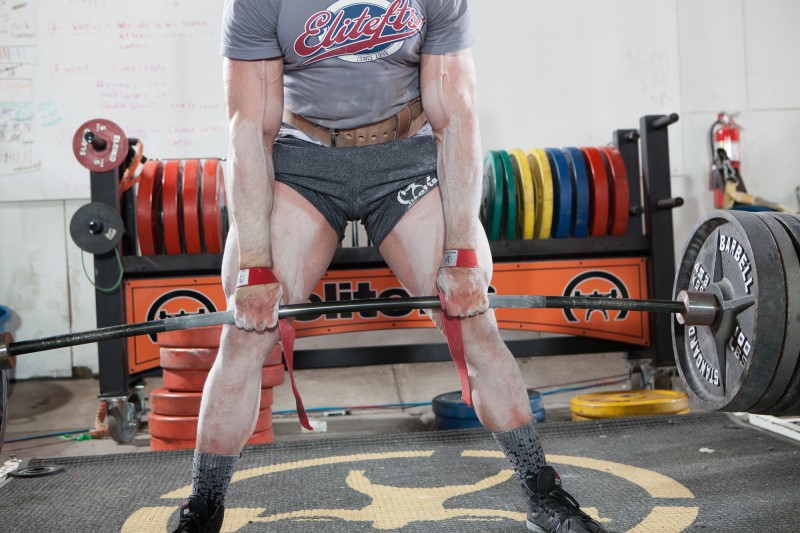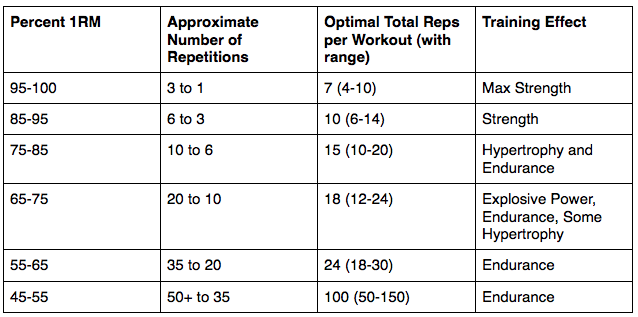
Deadlifts are fun. They are, in most cases, the exercise you can add the most weight to most quickly and then feel incredibly strong. I know a lot of casual lifters avoid this exercise, as you use a lot of weight and you’re using your back. In fact, it’s probably the exercise that I see performed incorrectly most often at the gym.
However, when a deadlift is done correctly it’s a safe exercise and it's pretty damn cool to lift a heavy weight like that off the floor. The way you’re taught to deadlift is the same as how your health and safety department at work would want you to pick things up off the floor. This shows how proper form in a deadlift can be effective in everyday life as well as your lifting life.
RELATED: Building the Raw Deadlift
Okay, now you’re sold. You want to deadlift, or you may already be deadlifting, but now you want to know how to get it as big and lift as heavy as possible. You want it so that when you load the bar the other people in the gym look a little scared? Good. Let’s do it.
In this article, we’ll go over the best way to add serious amounts of weight to your deadlift without risking injuries.
How to Conventional Deadlift
Without a doubt, this is the main and most important thing to get sorted, and it should be the very first thing you do. If you can’t get the barbell off the floor in the correct manner then an increase in weight will only highlight the inefficiencies in your movements and then lead to the lift not being finished cleanly. It’s better to take an extra week or two to nail your form at the beginning rather than to try to rebuild your form after you have started lifting heavy.
Here we will focus mainly on the setup of the deadlift. I know some of you may be thinking, "Well, my issue is with lockout and not getting it off the floor.” However, if you’re setup is absolutely spot on then it is unlikely that you will come out of position and lose your shape for the lockout.
Conventional Deadlift Setup
- Set your feet. By this, I mean setting the width of your feet and where they go in relation to the bar. Typically your foot width should be roughly heels in line with your shoulders and with your toes pointed out a little for increased glute involvement. In relation to the bar, you want it covering the bottom shoelace or the bottom of your toes. This gives you enough space to get down to the bar in a tight position without falling over.
- Squat down to the bar. This is where my advice differs a little from some of the more common advice. At this point, you want to keep your back in a tight position, squat down to the bar, and grab it. If you find that in the process of getting down to the bar you fall over, have your shoulders ahead of the bar, or are too far away from the bar, you should go back to setting your feet and bring them either slightly farther forward or farther back depending on the issue. You want it so that when you grab the bar there is enough space for your knees to come forward and let you align your shoulders with the bar, which you’ll do on the next step.
- Pull your hips into the bar. At this point, you want to pull the bar to take the slack out. As you do this, you also pull your hips gently into place. I usually suggest that people do this slowly at first so that they can feel where the hips feel strongest. You don’t want them so low so that you have to squat the bar off the floor, but you also don't want them so high that it's all back.
- Lift it. Do so in a controlled manner. Don’t just grip it and rip it. This is likely to result in your upper back just giving up. The vast majority of people simply don’t have the upper back strength to do this without their shoulders caving. Initially pulling like this can result in the bar coming off the floor very slowly, but you’ll get used to it and it will result in you maintaining your shape throughout the whole movement.
If you are used to a more "grip it and rip it" style of deadlift then the above setup might seem a bit slow at first. Stick with it. It’s good and brings results.
Now that I’ve gone over how to do a conventional deadlift, it’s time to discuss its less appreciated cousin: the sumo deadlift.
How To Sumo Deadlift
The sumo deadlift gets a bit of a bad rep, mainly from conventional deadlifters, due to it taking advantage of longer leverages and a shorter range of motion. However, these people aren’t likely to complain about low bar doing a similar thing for the range of motion on squats. Deciding between the two is as simple as following this wisdom:
- Conventional requires more quadriceps and lower back strength. Normally a good conventional lifter will have longer arms relative to their height.
- Sumo requires a more upright posture, comparatively longer legs (hence more ladies doing it than men), and stronger glutes and hamstrings.
Long arms in relation to your height means that you’re better suited to a conventional stance. I have seen lifters who have arms so long that their lockout has the bar a matter of inches away from the knees. Long legs in relation to your height often means you’re better suited for sumo.
Sumo Deadlift Setup
- Set your feet. Stand with your feet wide — so wide so that when you bend down in this position your shins are roughly vertical.
- Push the knees out and keep the back tight. Grab the bar at roughly shoulder width.
- Find your hip position. Get your hips and shoulders aligned so your back is not arched. You don’t want the hips too low, as this is likely to curve your lower back. If your hips are too high you’re likely to just "conventional deadlift" it off the floor while in a sumo stance.
- Begin with the feet. Dig your heels in and push the floor away.
- Knees before hips. Your knees are likely to lock as the bar passes them.
- Lockout! Stand up to straight. Do not hyperextend, but this is where you lock out your hips.
Just like I said for the conventional deadlift, make sure you don’t just try to rip it up off the floor, for the same reason as before. A successful sumo deadlift depends on your ability to stay in a very upright position, and a rip off the floor is likely to have you lose your shape.
Training Principles
Now that we have sorted your form out, you’re likely to be in a great position to move on and really focus on the nuances of training. This means a focus, and understanding, on training principles such as programming and diet. It is worth noting that programming can be separated out further into:
- Volume
- Intensity
- Frequency
- Fatigue
An understanding of these things will help you not only increase your deadlift but also approach training with a fresh perspective.
Frequency is massively dependent on other training factors, namely volume, intensity, and fatigue, all of which are factors in your programming. How you manipulate these factors towards your own style of training and your own lifestyle is how you make your training optimal. At its simplest, frequency is just how many times a week you train. In this case, it is how many times a week you train the deadlift.
Before we fully tackle frequency, we need an understanding of the other training principles involved. First up, volume.
Volume
Volume has been shown to be one of the most decisive factors in your training, regardless of whether your goal is strength or size. Volume incorporates:
- Time or duration
- Distance covered or weight lifted
- Number of repetitions performed
Intensity
Whereas volume is the quantitative variable, intensity is the qualitative one. The more work that a person does within a single session, the more intense that session is. The intensity depends on:
- Load
- Speed of performance
- Variation of rest between sets and reps
One point often overlooked about intensity is the psychological effect it can have on a person. In the case of strength or size gains, intensity would depend mainly on the load utilized in a workout. For example, reps at 80% would be a lot more intense than singles at 70%.
As the volume goes up in a workout, the intensity should come down, and vice versa. Whichever variable your training phase focuses on will have a different effect on your body’s adaptation. Finding the optimal balance of both can be a tricky task. Strength athletes could use Prilepin’s chart to this end.
If you’re a complete beginner, going straight into four times a week of training deadlift will likely result in your strength struggling. You need to start off slow and build it up at your own pace. The important part is that you organize your required volume into a reasonable schedule. The more experienced you are, the more volume you are likely to be able to endure.
This relates strongly to your body’s ability to recover. If you’re new to training and have never had to recover from a new amount of volume, the first few days after your initial sessions are going to hurt. Your central nervous system will basically react as though you have just tried to kill it and will make it so that you don’t try it again soon. Don’t worry, though; it is not always this hard to recover from. However, do keep in mind that your lower back will take longer to recover (due to the density of the muscles in the area) than most other muscles will.
MORE: Elitefts Deadlift Manual
With a bit more of an understanding of volume now, I want you to imagine that you try to cram a lot of deadlift volume into your workout too soon. You find that you are struggling to even finish a workout within an allotted time, and even if you do, you’re not improving. You’re also sore and tired between workouts, maybe even with sleep and sexual function affected. I know this sounds quite extreme, but this is what can happen when too much volume is thrown at a person. Here, it is about training smarter, not necessarily harder or more.
A lot of this will come down to practice, though. Now you’ve got a rough idea of how it works you could attempt a certain amount of volume and see how that works. If you’re showing signs of overtraining then you need to readjust, probably by lowering the volume or the frequency of your training.
Recommendations for Frequency
When it comes to frequency, you will need to keep it within reason. Generally, "deadlift more" would be great advice, but this can be misconstrued, hence these recommendations. As I have shown, volume and intensity cross over with this massively. The recommendations below come from Eric Helms’ "Muscle and Strength Pyramid."
- Your volume should be between 40 and 60 reps per muscle group per session. The intensity range is going to be dependent on your goals. As we are focusing on strength here, you should have 66% to 75% of your training in the one to six rep max range.
- Finally, the frequency at which you should train should be each body part or movement two to three times each week.
- The frequency here means that your volume should be between 80 and 210 reps per body part or movement per week.
As you can see, 80 to 210 reps per week is a huge range to play with. If you are a beginner, start off at the lower end and build it up.
Fatigue
You should be able to see that a controlled build-up of volume is what is needed. Push it too much, too soon, and your body will be stressed to an irrecoverable point. Push it too little and you will never progress beyond the initial beginner stage. With a controlled buildup and deload of volume, you will find that you can perform to a high standard.
The reason for this is what is known as compensation. This is where your body gets used to being broken down by training. For example, you could train so that your body goes down to 80%, leaving 20% to recover. The longer you keep doing this, the less efficient you will be at recovering. You might only recover by 15% up to 95%. The further you travel into this phase (known as "overreaching") the more you will need to recover, but the less efficient you’ll be. A good periodized plan would have you reach this point a few days to a week before a competition or testing day, and then you will go through a deload.
This deload will have a fairly drastic drop in volume and intensity. It is after a point in training like this where you will be able to test your true one-rep max in your deadlift.
Programming the Deadlift
You can see from above that you will have many factors to consider when planning out your deadlift improvements. For a beginner, I would recommend to only train the deadlift heavy once per week. You can train it a second day, but this should be a focus on technique and practice. As you become more of an intermediate lifter, this second day could be used as a deadlift assistance.
Once you’re an intermediate lifter, you would need to focus on fixing your weaknesses. These weaknesses generally tend to be related to either your starting position or your lockout. The form section above should help you massively with fixing your starting position, but there are also other exercises that may help.
Assistance for starting position:
- Deficit Deadlifts
- Eccentric Deadlifts
Assistance for lockouts:
It may also be good for you to practice the alternative lift to yours on the other day (e.g. if you’re conventional practice sumo, and vice versa). Deciding which assistance exercises will depend largely on you, where you’re weakest, and where you’re strongest.
Diet
As with any strength-building program, you are always going to fare better when you focus on consuming more calories than you expend. You are most likely to gain strength along with weight on a bulk. This isn’t to say you can’t continue to progress on a cut (and it depends on your dieting and training history and level) but you minimize your chances of getting beastly strong if you do.
To Sum Up
To increase your deadlift you will have to focus on the form. This should be first and foremost. You should then look at a solidly organized program. This should coincide with a diet tailored to you for you to meet your goals. This should be a lifestyle; focus on getting stronger in everything and you'll add serious weight to your deadlift.
Kyran Doyle is a certified, incurable workaholic. When he’s not lifting heavy things he can be found online at fitnesscrest.com. His goal is to humbly empower others to grow stronger and take control of their health and fitness as he continues to grow himself as a lifter.












